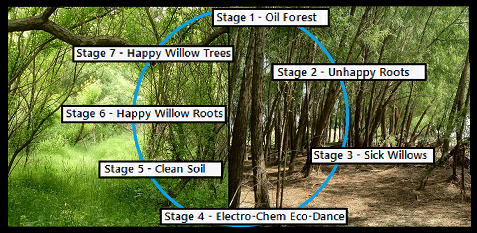"Sauces en el Campo Petrolífero (Willows in the Oil Field)" - Sound Myth #9 by the Chaos Era. Produced by Willi Paul & Planetshifter.com
"Sauces en el Campo Petrolífero (Willows in the Oil Field)" - Sound Myth #9 by the Chaos Era. Produced by Willi Paul & Planetshifter.com
- Enjoy the
Youtube Version –
* * * * * * *
- Journey Map -
Symbols: Oil-soaked soil, Machines, Willow Trees, Roots, Clean Soil
Environmental Archetype: Oil pollution, Dirty land, Cleaning oil-soaked land for Nature
New Stories: "
Plants, fungi and bacteria work together to clean polluted land"
Sound Archetypes: Rain, Machines, Fear, Cheering
Sound Myth: U2 - "Where The Streets Have No Name"
* * * * * * *
- Track List (Stages) –
1 - Oil Forest
2 - Unhappy Roots
3 - Sick Willows
4 - Electro-Chem Eco-Dance
5 - Clean Soil
6 - Happy Willow Roots
7 - Happy Willow Trees
See the Source Document:
"
"Plants, fungi and bacteria work together to clean polluted land"
- Excerpts -
Genetic analysis shows microbial interactions help fast-growing trees break down petrochemical pollutants in soil
New genetic evidence suggests willow trees may tolerate pollution by providing sugars to symbiotic fungi surrounding their roots; the fungi, in turn, provide nutrients to hydrocarbon-degrading bacteria.
Trees, fungi and bacteria: tripartite meta-transcriptomics of a root microbiome responding to soil contamination.
Fast-growing trees, such as willows, are known to tolerate and even rejuvenate soil contaminated with petroleum by-products or heavy metals. The clean-up of soil in this way is known as phytoremediation, and the process is commonly attributed to "secondary metabolism" – the production of specialized compounds in plants that helps them cope with environmental stress.
Using advanced techniques for analyzing the simultaneous expression of genes from multiple organisms in an ecosystem, the scientists examined the roots of willows grown on a polluted site in suburban Montreal. They found that complex interactions among a range of ectomycorrhizal fungi -- which form symbiotic sheaths around the roots of plants -- and certain bacteria appeared to drive the degradation of hydrocarbons in the ground.

